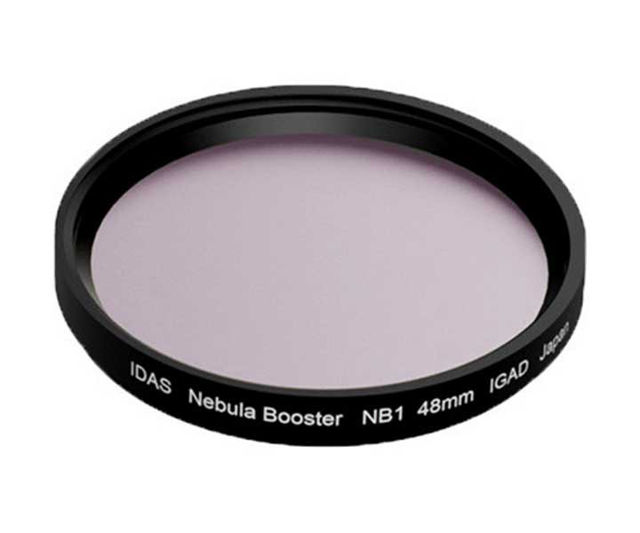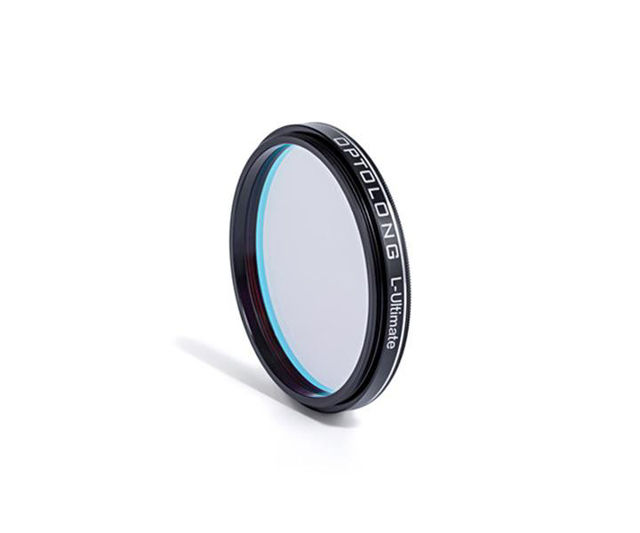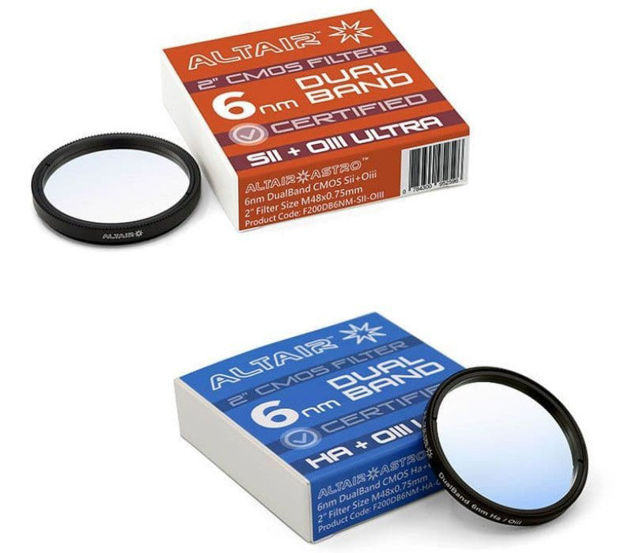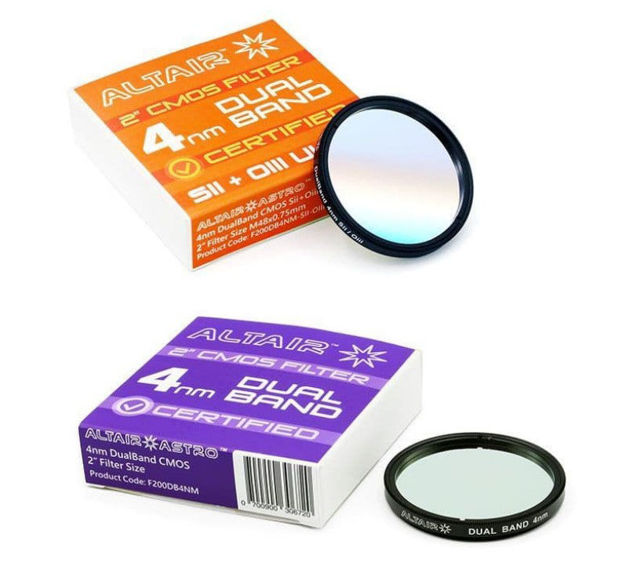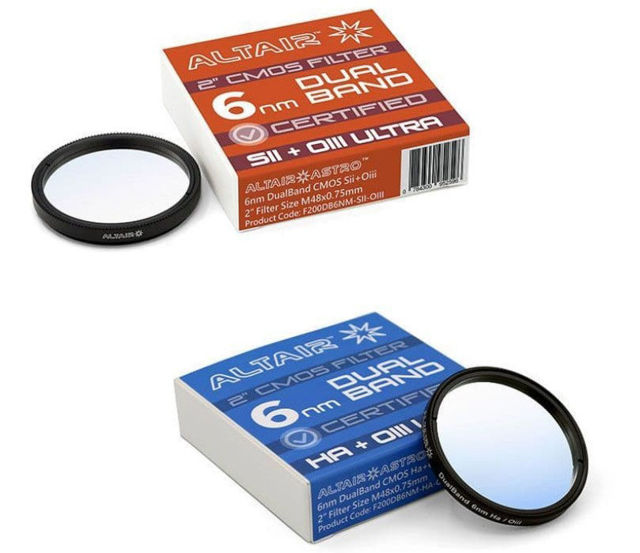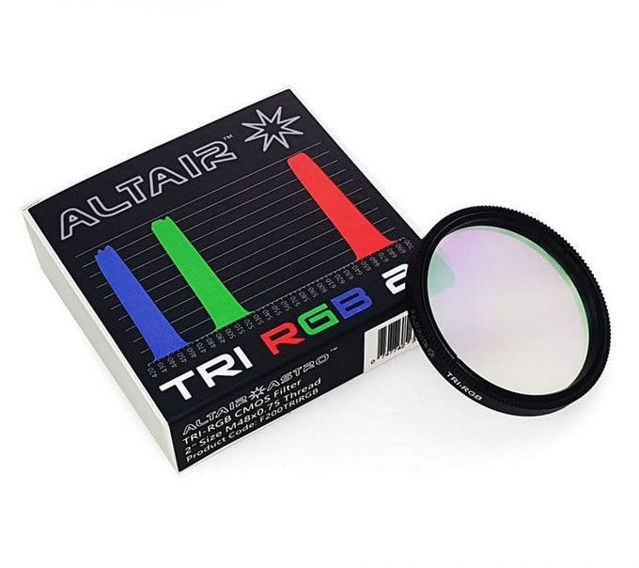Multiband-Filters
- Home /
- Optical Accessories /
- CCD Filter for Astrophotography /
- Multiband-Filters
The nebula filter passes H-Beta, O-III and H-Alpha and is designed for astrophotography.
- IDAS nebula filters are produced in Japan
- The NB1-48 is supplied in a filter cell with M48x0.75 / 2" filter thread
- Exposure time factor 4 - four times the exposure time is possible before you reach the sky background.
- The filter is especially well suited for tricolor shots of nebulae with color cameras
- Scattered light and nightglow are effectively suppressed, leaving stars and sky background relatively neutral
- High-quality anti-reflection coating
- Scratch-resistant hard coating
- With 2.5 mm thickness the filter is parfocal to other IDAS filters
- The infrared light is blocked, so the filter also fulfills the function of an IR blocking filter.
264.00 €
Estimated delivery time : 3-4 days
This dual band filter is designed to drastically reduce the effect of light pollution, it isolates the nebulae´s emissions into H-Alpha (red) and OIII (green-blue) and blocks light pollution.
- Transmits the main nebula lines at 656.3 nm and 500.7 nm with 3 nm bandpass
- Blocks light pollution and skyglow
- Designed mainly for astrophotography
- Especially suited for color cameras
- Ideal for urban areas with extreme light pollution
- Incorporates UV/IR cut filter
- Multi layers anti reflection coating
- Ultra thin filter cell maximises compatibility with filter wheels
399.00 €
Estimated delivery time : 1-4 days
This is the filter for imaging in moonlight or light pollution with a colour CMOS camera - or even in dark-sky conditions if you want total isolation and control over your channels, narrowband-style.
Altair DualBand 6nm ULTRA Filter Features:
- Capture two main emission nebulae bands at the same time, per filter, whilst suppressing light pollution, moonlight, and airglow.
- Acquire more data in less time, opening up your imaging window, even into the summer months when it isn't quite dark.
- If you have the 6nm Sii Oiii Ultra filter and the Ha Oiii filter combo, you can capture twice the Oiii data in each imaging session and combine them for true SHO Hubble style imaging with a colour camera!
- Extremely steep bandpass yields maximum contrast in extreme light pollution: 6nm FHWM centred on 500.7nm Oiii wavelength, 5.5nm FHWM centred on the Sii and Ha wavelengths.
- Can be used with One Shot Colour (OSC) CMOS or mono astronomical cameras for luminance data.
- Includes UVIR blocking for both modified and un-modified DSLR cameras, plus an anti-reflection coating for the ultimate in contrast.
- Best performance at focal ratios at F4.8 or slower, however can be used as fast as F3.6, with minimal contrast impact (conservative estimate - faster may be possible). Like any dichroic filter, contrast increases as focal ratio number increases. More info about light pollution filter performance and focal ratio here.
- Available in 1.25" or 2" standard astronomy filter sizes. The filters have standard Astronomy compatible filter threads, and fit inside the Altair Magnetic Filter holders (with appropriate slider), and standard astronomy filter wheels. Choose the 2" version for use with the Altair Canon / Nikon DSLR lens to astro CMOS adaptors. For Hypercam 183C and 533C or 533M, 585C and smaller sensors choose the 1.25" filter. For larger sensors choose the 2" version.
392.00 € 352.80 €
Estimated delivery time : 1-2 weeks
Altair DualBand 4nm Filter Features:
- Capture the two main emission nebulae bands at the same time, whilst suppressing light pollution, moonlight, and airglow.
- More data in less time, opening up your imaging window, even into the summer months when it isn't quite dark yet. Capture twice the Oiii data, whilst obtaining Sii to complement the Altair Ha Oiii DualBand filter.
- Extremely steep bandpass yields maximum contrast in extreme light pollution: 4nm FHWM centred precisely on the target wavelengths.
- Can be used with One Shot Colour (OSC) CMOS or mono astronomical cameras for luminance data.
- Includes UVIR blocking for both modified and un-modified DSLR cameras, plus an anti-reflection coating for halo suppression. To see the AR coating in action, please see images demonstrating the same filter with and without the AR coating on the bright star, Capella in exactly the same conditions with the same settings.
- Best performance at focal ratios as fast as F4.8, with contrast increasing as focal ratio increases. More info about light pollution filter performance and focal ratio here.
- The 2" filter has standard M48x0.75mm thread, and fits inside the Altair Magnetic Filter holders, standard 2" filter wheels, plus the Altair Canon / Nikon DSLR lens to astro CMOS adaptors.
1133.00 €
Estimated delivery time : 1-2 weeks
This is the filter for imaging in moonlight or light pollution with a colour CMOS camera - or even in dark-sky conditions if you want total isolation and control over your channels, narrowband-style.
Altair DualBand 6nm ULTRA Filter Features:
- Capture two main emission nebulae bands at the same time, per filter, whilst suppressing light pollution, moonlight, and airglow.
- Acquire more data in less time, opening up your imaging window, even into the summer months when it isn't quite dark.
- If you have the 6nm Sii Oiii Ultra filter and the Ha Oiii filter combo, you can capture twice the Oiii data in each imaging session and combine them for true SHO Hubble style imaging with a colour camera!
- Extremely steep bandpass yields maximum contrast in extreme light pollution: 6nm FHWM centred on 500.7nm Oiii wavelength, 5.5nm FHWM centred on the Sii and Ha wavelengths.
- Can be used with One Shot Colour (OSC) CMOS or mono astronomical cameras for luminance data.
- Includes UVIR blocking for both modified and un-modified DSLR cameras, plus an anti-reflection coating for the ultimate in contrast.
- Best performance at focal ratios at F4.8 or slower, however can be used as fast as F3.6, with minimal contrast impact (conservative estimate - faster may be possible). Like any dichroic filter, contrast increases as focal ratio number increases. More info about light pollution filter performance and focal ratio here.
- Available in 1.25" or 2" standard astronomy filter sizes. The filters have standard Astronomy compatible filter threads, and fit inside the Altair Magnetic Filter holders (with appropriate slider), and standard astronomy filter wheels. Choose the 2" version for use with the Altair Canon / Nikon DSLR lens to astro CMOS adaptors. For Hypercam 183C and 533C or 533M, 585C and smaller sensors choose the 1.25" filter. For larger sensors choose the 2" version.
619.00 € 599.00 €
Estimated delivery time : 1-2 weeks
This filter was developed to suppress light pollution for colour and monochrome cameras and offers more balanced RGB colours.
- ltair TRI-RGB is great for broadband objects such as mixed emission / reflection nebulae, comets, dust clouds and galaxies, but it also allows the major emission nebulae lines through. It covers both broadband AND narrowband targets.
- TRI-RGB complements the Altair TriBand and DualBand filters by adding star colours.
- TRI-RGB and works with fast or slow focal ratio telescopes and camera lenses.
- TRI-RGB is not only for light pollution control. It works very well under dark skies too by enhancing colour purity, airglow and reducing channel crossover in colour CMOS and DSLR cameras.
- Although primarily intended for colour cameras, TRI-RGB can be used for a cleaner luminance channel with a mono camera.
- High transmission peaks with steep sides enhance contrast, together with almost total suppression of unwanted light, at OD4/5 (0.01%~0.001%) over the majority of unwanted visual wavelengths.
279.00 € 259.00 €
Estimated delivery time : 1-2 weeks



